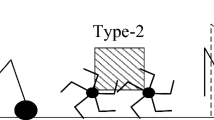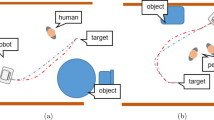Abstract
Biped locomotion has excellent environment adaptability due to natural selection and evolution over hundreds of millions years. However, the biped walking stability mechanism is still not clear. In this paper, an experimental analysis of walking stability in human walking is carried out by using a motion capture system. A new stability analysis method is proposed based on Zero Moment Point (ZMP) and Sliding Time Window (STW). The influences of ground friction coefficient, ground slope angle and contact area of support polygon on human walking stability are investigated. The experiment is carried out with 12 healthy subjects, and 53 passive reflective markers are pasted to each subject to obtain moving trajectory and to calculate lower limb joint variation during walking. Experimental results show that ground friction coefficient, ground slope angle and contact area have significant effects on the stride length, step height, gait cycle and lower limb joint angles. When walking with small stability margin, subjects modulate gait to improve the stability, such as shortening stride length, reducing step height, and increasing the gait cycle. These results provide insights into the stability mechanism of human walking, which is beneficial for locomotion control of biped robots.
Similar content being viewed by others
References
Zhu H, Luo M, Mei T, Zhao J, Li T, Guo F. Energy-efficient bio-inspired gait planning and control for biped robot based on human locomotion analysis. Journal of Bionic Engineering, 2016, 13, 271–282.
Li T, Ceccarelli M, Luo M, Laribi M A, Zeghloul S. An experimental analysis of overcoming obstacle in human walking. Journal of Bionic Engineering, 2014, 11, 497–505.
Sakagami Y, Watanabe R, Aoyama C, Matsunaga S, Higaki N, Fujimura K. The intelligent ASIMO: System overview and integration. Proceedings of IEEE/RSJ International Conference on Intelligent Robots and Systems, Lausanne, Switzerland, 2002, 2478–2483.
Tedrake R, Kuindersma S, Deits R, Miura K. A closed-form solution for realtime ZMP gait generation and feedback stabilization. Proceedings of IEEE-RAS 15th International Conference on Humanoid Robots, Seoul, Korea, 2015, 936–940.
Clever D, Harant M, Mombaur K, Naveau M, Stasse O, Endres D. Cocomopl: A novel approach for humanoid walking generation combining optimal control, movement primitives and learning and its transfer to the real robot HRP-2. IEEE Robotics and Automation Letters, 2017, 2, 977–984.
Geppert L. Qrio, the robot that could. IEEE Spectrum, 2004, 41, 34–37.
He B, Wang Z, Shen R, Hu S. Real-time walking pattern generation for a biped robot with hybrid CPG-ZMP algorithm. International Journal of Advanced Robotic Systems, 2014, 11, 160.
He B, Lu Q, Wang Z. Coupling effect analysis between the central nervous system and the CPG network with proprioception. Robotica, 2015, 33, 1281–1294.
Qian Z, Ren L, Ren L Q. A coupling analysis of the biomechanical functions of human foot complex during locomotion. Journal of Bionic Engineering, 2010, 7, S150–S157.
Zhao G R, Ren L, Ren L Q, Hutchinson J R, Tian L M, Dai J S. Segmental kinematic coupling of the human spinal column during locomotion. Journal of Bionic Engineering, 2008, 5, 328–334.
Gao C, Oksa J, Rintamäki H, Holmer I. Gait muscle activity during walking on an inclined icy surface. Industrial Health, 2008, 46, 15–22.
Kwon J W, Son S M, Lee N K. Changes of kinematic parameters of lower extremities with gait speed: A 3D motion analysis study. Journal of Physical Therapy Science, 2015, 27, 477–479.
Bruijn S M, Meijer O G, Beek P J, van Dieën J H. The effects of arm swing on human gait stability. Journal of Experimental Biology, 2010, 213, 3945–3952.
Kang H G, Dingwell J B. Effects of walking speed, strength and range of motion on gait stability in healthy older adults. Journal of Biomechanics, 2008, 41, 2899–2905.
Hak L, Houdijk H, Steenbrink F, Mert A, van der Wurff P, Beek P J, van Dieën J H. Speeding up or slowing down?: Gait adaptations to preserve gait stability in response to balance perturbations. Gait & Posture, 2012, 36, 260–264.
Debbi E M, Wolf A, Haim A. Detecting and quantifying global instability during a dynamic task using kinetic and kinematic gait parameters. Journal of Biomechanics, 2012, 45, 1366–1371.
Zhou C, Wang X, Li Z, Tsagarakis N. Overview of gait synthesis for the humanoid COMAN. Journal of Bionic Engineering, 2017, 14, 15–25.
Shin H K, Kim B K. Energy-efficient gait planning and control for biped robots utilizing vertical body motion and allowable ZMP region. IEEE Transactions on Industrial Electronics, 2015, 62, 2277–2286.
Sugihara T, Yamamoto T. Foot-guided agile control of a biped robot through ZMP manipulation. Proceedings of IEEE/RSJ International Conference on Intelligent Robots and Systems, Vancouver, Canada, 2017, 4546–4551.
Shin H K, Kim B K. Energy-efficient gait planning and control for biped robots utilizing the allowable ZMP region. IEEE Transactions on Robotics, 2014, 30, 986–993.
Caron S, Pham Q C, Nakamura Y. ZMP support areas for multicontact mobility under frictional constraints. IEEE Transactions on Robotics, 2017, 33, 67–80.
Luat T H, Kim Y T. Fuzzy control for walking balance of the biped robot using ZMP criterion. International Journal of Humanoid Robotics, 2017, 14, 1750002.
Lee C H, Lin C R, Chen M S. Sliding window filtering: An efficient method for incremental mining on a time-variant database. Information Systems, 2005, 30, 227–244.
Vicon nexus, [2018-02-12], https://doi.org/www.vicon.com.
Chen H M, Zhang Y Z, Niu Y P, Song C F, Shangguan B. The mechanical principle of slipping when walking with different surface conditions. Chinese Science Bulletin, 2016, 61, 2629–2636.
Kim J W, Tran T T, Van Dang C, Kang B. Motion and walking stabilization of humanoids using sensory reflex control. International Journal of Advanced Robotic Systems, 2016, 13, 77.
Acknowledgment
The work was supported by National Natural Science Foundation of China (Grant Nos. 51605334, U1713215 and 51705368), Shanghai Municipal Science and Technology Commission Project (Grant Nos. 17DZ1203405 and 18DZ1202703), and Shanghai Sailing Program (Grant No. 17YF1420200). We thank the reviewers and editors for their helpful comments on the manuscript.
Author information
Authors and Affiliations
Corresponding author
Rights and permissions
About this article
Cite this article
Wang, Z., He, B., Zhou, Y. et al. An Experimental Analysis of Stability in Human Walking. J Bionic Eng 15, 827–838 (2018). https://doi.org/10.1007/s42235-018-0070-4
Published:
Issue Date:
DOI: https://doi.org/10.1007/s42235-018-0070-4




